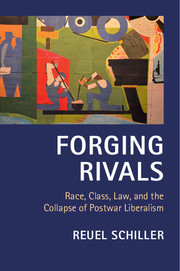Book contents
- Frontmatter
- Dedication
- Epigraph
- Contents
- Acknowledgments
- Introduction: Legal History and the Death of Postwar Liberalism
- 1 Forging Postwar Liberalism
- 2 Ed Rainbow's Problem
- 3 The Phony Commission
- 4 A Tale of Two Propositions
- 5 1966: A Terrible Year for George Johns
- 6 “The Day of the Minstrel Show Is Over”
- 7 Forging Rivals, Shattering Liberalism
- List of Abbreviations for Archival Sources
- Notes
- Index
7 - Forging Rivals, Shattering Liberalism
Published online by Cambridge University Press: 05 April 2015
- Frontmatter
- Dedication
- Epigraph
- Contents
- Acknowledgments
- Introduction: Legal History and the Death of Postwar Liberalism
- 1 Forging Postwar Liberalism
- 2 Ed Rainbow's Problem
- 3 The Phony Commission
- 4 A Tale of Two Propositions
- 5 1966: A Terrible Year for George Johns
- 6 “The Day of the Minstrel Show Is Over”
- 7 Forging Rivals, Shattering Liberalism
- List of Abbreviations for Archival Sources
- Notes
- Index
Summary
If ever there was a pyrrhic victory for the labor movement, it was Emporium Capwell. The case protected unions from the schismatic behavior of their members by reaffirming the basic premises of postwar industrial pluralism: exclusive representation and majoritarian decision making within bargaining units. Unfortunately, despite the myopic fears of the AFL-CIO graying leadership, the need to protect local union bargaining agents like Walter Johnson from dissatisfied minority workers who wished to circumvent the union grievance process was the least of the labor movement's problems in 1975. That year, the percentage of nonagricultural workers in labor unions fell to less than 22 percent, down from a postwar high in 1954 of almost 35 percent. Indeed, since 1954 union density had declined every year but two. The worse, of course, was yet to come. In subsequent years, union density would continue to plummet. By the turn of the century it would hover just above 12 percent. Indeed, even that figure fails to fully illustrate the crisis within the American labor movement, hiding, as it does, the utter collapse of industrial unionism in the United States. By the year 2000, only the existence of public-sector unions kept union density figures above 10 percent. That year, less than 8 percent of private-sector, nonagricultural workers were represented by a union.
Nor were the labor movement's losses limited to the workplace. By the middle of the 1970s, labor's political power was dissipating as well. Although the movement as a whole stayed wed to the Democratic Party, the membership began to ignore its leaders, turning away from the Party of the New Deal to vote in increasing numbers for illiberal candidates such as George Wallace, Richard Nixon, and Ronald Reagan. Even labor's power within the party had diminished. In 1972 and 1976, labor was stuck with Democratic candidates for president that it was, at best, lukewarm about. The AFL-CIO refused to endorse George McGovern in 1972.
- Type
- Chapter
- Information
- Forging RivalsRace, Class, Law, and the Collapse of Postwar Liberalism, pp. 220 - 256Publisher: Cambridge University PressPrint publication year: 2015



